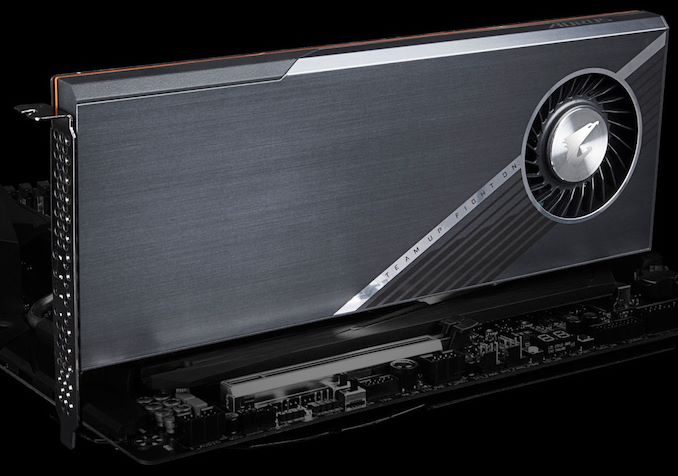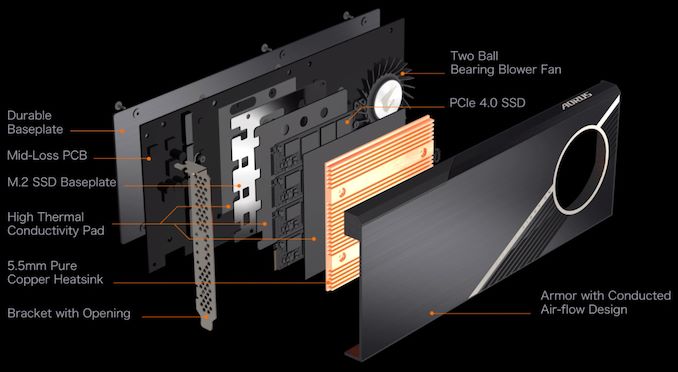GIGABYTE’s Aorus Gen4 AIC SSD 8 TB Launched: Up to 15 GB/s
by Anton Shilov on September 19, 2019 6:30 PM EST
After originally showcasing it at Computex a bit earlier this year, GIGABYTE has officially introduced its quad-SSD PCIe 4.0 adapter card, the AORUS Gen4 AIC. Designed house up to 4 NVMe SSDs, the card is essentially a multi-way M.2 adapter, allowing a PCIe 4.0 x16 slot to be used to drive four x4 SSDs. Fittingly, with so many high-end SSDs on a single board, the card also features an active cooling system to ensure that the drives run at consistent speeds even under high loads. Fully populated with PCIe 4.0 SSDs, the card is rated to provide up to a staggering 15 GB/s of throughput – at least, if you can come up with a workload that can saturate such a setup.
GIGABYTE’s Aorus Gen4 AIC SSD 8 TB is a PCIe 4.0 x16 board with eight PCIe Gen 4 re-drivers. The card in turn carries four 2 TB M.2-2280 SSDs based on Phison’s PS5016-E16 controller, which remains the only client SSD controller with a PCIe 4.0 x4 interface. The card also features a sophisticated cooling system comprising of a large copper heatsink, a 5-cm ball bearing fan, and a baseplate, along with eight thermal sensors to monitor everything. That monitoring, in turn, is provided by the Aorus Storage Manager software, which can also configure the cooling on the card and supports three fan operating modes, including Silent, Balanced, and Performance.
When running in RAID 0 mode, the Aorus Gen4 AIC SSD 8 TB offers up to 15 GB/s sequential read/write speeds, as well as 430K/440K read/write IOPS. It goes without saying that this is a throughput-focused card, as outside of the difficulty in even coming up with that many IOPS in a client workload, RAID modes don't really improve IOPS.
While the sequential performance of the Aorus Gen4 AIC SSD 8 TB looks extremely attractive, there is a caveat. The only enthusiast-class PCIe Gen 4-supporting platform today is AMD’s Ryzen 3000, and these CPUs only support 24 PCIe 4.0 lanes: x16 for an add-in-card, x4 for an NVMe SSD, and x4 to connect to the chipset. As a result, to make full use of the card you have to give up a board's sole PCIe 4.0 x16 slot for the SSD, which makes this a niche product for systems that don't need a powerful dGPU. Otherwise, installing the drive into a PCIe x16 slot controlled by AMD’s X570 chipset would cause it to be bottlenecked by the PCIe 4.0 x4 link between the chipset and the CPU.
That said, the Aorus Gen4 AIC SSD 8 TB can show itself in all the glory either in a workstation based on AMD’s EPYC 7000-series processor with up to 128 PCIe Gen 4 lanes, or, presumably, in a future high-end desktop based on next-generation AMD Threadripper CPU.
Related Reading:
- Liqid to Demonstrate Element LQD4500 PCIe 4.0 x16 SSD: 32 TB At Up to 24 GB/s
- GIGABYTE Shows PCIe 4.0 x16 Four-Way M.2 PCIe Add-In Card
- Phison Previews Next-Gen PCIe 4.0 SSD Controllers: Up to 7 GB/s, NVMe 1.4
- Phison’s PS5016-E16 & PS5019-E19: The First PCIe 4.0 Client SSD Controllers
- GIGABYTE Teases PCIe 4.0 M.2 SSD in Press Release: 5 GB/s
Source: GIGABYTE (via Hermitage Akihabara)












24 Comments
View All Comments
PeachNCream - Friday, September 20, 2019 - link
Sure I'd like a faster storage subsystem, but maybe one that's relevant to mobile systems. Not many people are still buying desktops these days.TheinsanegamerN - Friday, September 20, 2019 - link
Enough people are buying desktop parts for stuff like this to be developed. Sales of HDET and gaming hardware is stronger then ever, its only offset by the collapse of office PC sales.Mobile systems are too power and space limited for "faster storage subsystems" to be relevant to them. You can already push 3.5GB/s through NVMe over PCIe 3. Thunderbolt 3 enclosures already edxist for rapid storage transfers on a mobile platform.
PeachNCream - Friday, September 20, 2019 - link
I think the primary purpose of reaching upward in the performance stack this high is to raise margins to make up for the loss of sales volume. LED lighting, mechanical keyboards, premium mice, audiophile headsets for PC gamers. Those are all indicators that sales numbers losses are forcing edge parts into the industry which is thereby shouldering out cost sensitive buyers and helping deflate sales. As numbers tilt onto cheaper budget systems or mobile phones, that's where software development will land, making high end systems for gaming at least, progressively less relevant. We're in a feedback loop as the market segment suffers from declines.SetiroN - Friday, September 20, 2019 - link
What a stupid comment.DanNeely - Friday, September 20, 2019 - link
And if it was an m.2 drive you'd whine that it was too expensive for your bottom barrel race to the bottom in poverty/extreme cheapskatedness system.PeachNCream - Friday, September 20, 2019 - link
It doesn't take a lot of effort to build net worth. I get that it seems exceptionally difficult, but even as a single income, single parent with two kids, it took 2.5 years to add $100k in net worth (which happens to have happened with today's paycheck and 2.5 years after divorce) and I've never been in debt, not even for a mortgage and my deadbeat ex doesn't pay child support. *shrug* Pick how you live, but don't get too upset at people that put a priority on paying their future self over paying others. I want to put my feet up and relax someday (normal retirement age as opposed to some FIRE kind of early out thing) and being a cheapskate is part of goal attainment. Despite cutting corners, I still have everything I need and most of what I want.DanNeely - Friday, September 20, 2019 - link
If part of your saving plan is buying the cheapest possible tech and using it until is fails, more (or should I say less) power to you; but as long as your tech spending is adjusted that way, virtually nothing this site reviews will be relevant to you and your "I'm cheap, I don't care" comments on almost every article about performance hardware don't add any value.I do however feel compelled to rebut your implication that anything other than bottom end tech is incompatible with good financial health. I'm on track to be able to retire in my mid/late 50's while being able to match my current gross income from savings (and several years earlier if only looking at the part I see). While I could squeeze a few thousand/year more out of my budget I'd be cutting into comfort areas to do so; and computer gaming is my primary recreational activity so a relatively high end system is an expense I'm quite comfortable with. (which is not whatever this ends up costing, despite the Aorus branding it's clearly a workstation product.)
PeachNCream - Friday, September 20, 2019 - link
There's nothing stopping you from spending on what you want. My comment, the one that drew your ire, was that desktop sales have declined dramatically and parts like these aren't relevant to the mobile/portable transition the world is experiencing. You decision to interpret and draw the conclusion you have makes it pretty clear you have sensitivities about your own spending habits on your hobby. It's cool, we all waste money of stuff. I feed the neighbor's cat premium cat food when it comes over to say hi because I want him to come over to say hi.I will point out though, that a lot of my free time is spent playing computer games and I am not want for computer power. It's simply a matter of pairing up games with whatever hardware you happen to have as opposed to buying at the upper end of the price/performance curve. Cataclysm: DDA runs peachy on a single core Atom netbook and it's the kind of game that can eat your free time for lunch and then ask for dessert and a snack. The main dev stated that the ASCII curses version ran over SSH on a Lego EV3 brick which is like a 300Mhz 64MB RAM toy with adapted Debian included with Mindstorm sets. Gaming on a PC is about having fun and there's a whole spectrum of ways to get to that point. Doing it on the cheap is also one of many ways to trim the fat and if you dismiss that as only a few dollars here or there per year and don't bother socking for the future because of that in more than just gaming, well, yeah I can see why you'd want to go on the attack at a cheapskate like me and it's all good. I'm not bothered by it. If someone else reads this and thinks, "Hmm, if Peach can do it, maybe I can look at my future a little bit more and work that compound interest magic too."
Supercell99 - Friday, September 20, 2019 - link
Is your CPU going to process at 15GB/sec? I am not sure what the use case for this drive isDanNeely - Friday, September 20, 2019 - link
Workloads with a dataset too large to fit into ram, either because you already maxed it out without being able to fit your entire working set in; or because a crazy fast/expensive drive is still cheaper than doubling the amount of ram again.So stuff like giant rendering/cad/compute projects. Maybe some server roles, although raiding smaller drives on a backplane is probably a better option than a single expansion card for that role.